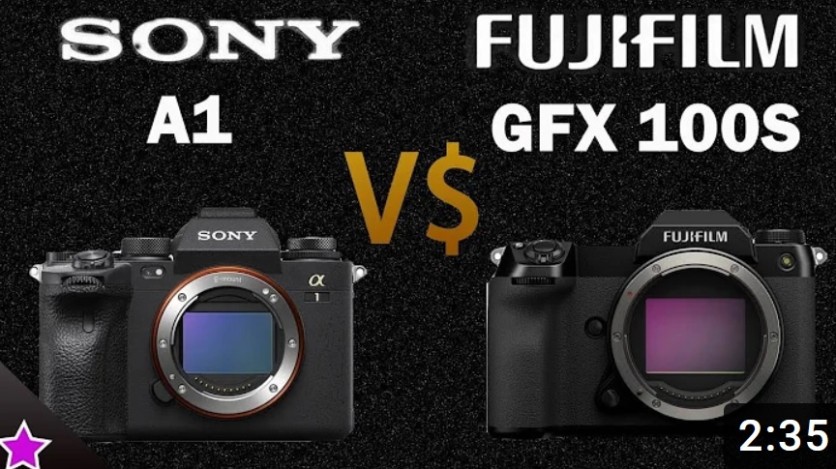
The battle of the mirrorless cameras and the two biggest releases of 2021, Sony A1 and Fujifilm GFX100S will now be discussed as we know who has more edge when it comes to different features.
While both products are high-end, the comparison will only come down to one: who is the clear winner of the 'mirrorless' war between the two powerhouse cameras?
Fujifilm GFX100s vs Sony A1 Cost
First, we will start at their prices. According to Digital Camera World, Sony A1 cost $6,499, and it was compared to Canon EOS R5, the former made Canon an inferior camera. On the other hand, Fujifilm GFX100S is priced at $5,999. Between Sony A1 and Fujifilm GFX 100S, Sony A1 appears to be the pricier, but that does not mean that it is still the winner.
Body Size, Cam Sensor, Screen, and EVF
When it comes to size, Fujifilm GFX100S is bigger than Sony A1. Sony is 80.8 mm in thickness and 128.9 mm in width while the Fujifilm is 87.2 mm thicker and 150 mm wider. In height, Fujifilm stands taller at 104 mm compared to Sony's 96.9 mm.
For the sensor, Fujifilm is bulkier at 43.8 x 32.9 mm surface while Sony has 35.9 x 24 mm. For the megapixel, GFX100S is two times greater in resolution at 102 MP than A1's 50.5 MP. Its larger frame made it more reliable when placed in ISO or tripod which handles sensitivity issues much better than A1.
If you consider a lighter camera good for your pouch, Sony is the winner at 737 g compared to Fujifilm's 900g camera. If you want to run and cover fast events, consider getting Sony.
What's different with Fujifilm's screen compared to Sony? Its display is fantastic as it can be pointed upward. If you want to til it to the right, rotate it to 45 or 60 degrees. The bonus? It's a touchscreen.
On the other hand, Sony A1 is more on a retro-styled screen, where it can be tilted upward and downward. It might sound outdated but some photographers preferred this kind of screen.
Between Fujifilm and Sony, GFX100s have a higher screen resolution at 1024 x 768 pixels at 3.2 inches, while A1 only has a three-inch screen at 800 x 600 pixels.
But, in Electronic ViewFinder (EVF), Sony brags its magnificent 0.64-inch OLED panel which can magnify a shot for 0.9x. A1's focus is beyond perfection at 2048 x 1536 pixels, which is even higher than full HD. GFX100s, on the other hand, have 0.77x magnification and only 720p resolution at 1280 x 960 pixels. If you prefer shooting in dark places, go for Fujifilm with its monochrome mode OLED.
Autofocus, Bust performance, and Battery
You can burst-shoot on Fuji for three seconds with its 5fps top speed. It takes 16 raw shots for its buffer to run out. Sony meanwhile is at 30fps. If you want to use the mechanical shutter, its fps will become 10fps. A1 can slot 238 raw shots for its buffer, so for the bust performance, go with Sony.
A1's speed has a more upper hand than Fuji's. Sony's autofocus for mirrorless cameras is perfect for its full-frame build. In addition, its phase detection of 759 points occupies 9% of its frame. Meanwhile, Fuji's autofocus can only reach up to 425 phase-detection marks.
For the battery life, Sony A1 is much better as it can shoot for 530 stills and 150 minutes for straight video. Fujifilm GFX100S can only capture 460 stills and 110 minutes of video at 1080p. If you want to shoot a 4K video, Fuji can only be used for 95 minutes.
Key Takeaways
Fujifilm seems to be more amazing if you want to go for sports photography. Sony falls short on that category but its autofocus says it all - a dominant burst shooting for video capturing.
To summarize, Sony A1 offers a lot of versatility compared to Fujifilm GFX100S. More so, Fujifilm excels as a medium format camera. Either way, these cameras are a win-win for all photographers.
This article is owned by Tech Times
Written by Joen Coronel




![Most Useful Google Chrome Keyboard Shortcuts You Need to Know to Improve Your Browsing Experience [2024]](https://d.techtimes.com/en/full/449047/most-useful-google-chrome-keyboard-shortcuts-you-need-know-improve-your-browsing-experience-2024.jpg?w=184&h=103&f=476d29fd60df70a67f6679f99a2ca6d0)